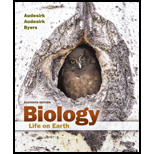
Concept explainers
Animal cells are surrounded by ______ fluid. This fluid is_____ to thecytosol.
a. phospholipid; isotonic
b. plasma; hypertonic
c. interstitial; isotonic
d. interstitial; hypotonic
Introduction:
Animals are eukaryotes and therefore their cells are highly organized. They have a phospholipid membrane, which is bilayered and encloses the cell’s contents like organelles, proteins, and ribosomes in the cytosol.
Answer to Problem 1MC
Correct answer:
Interstitial fluid surrounds animal cells and is isotonic with respect to the cytosol.
Explanation of Solution
Justification for the correct answer:
Option (c) is given that isotonic, interstitial fluid surrounds the animal cells. This is a true statement as interstitial fluid is a part of the extracellular matrix (ECM). The water cannot enter or exit the cell because of equal concentration of solute and water in the cytosol and the interstitial fluid. Hence, option (c) is correct.
Justification for incorrect answers:
Option (a) is given that a phospholipid fluid encloses the animal cell and this fluid is isotonic. This is false as phospholipid is a component of the cell membrane and not the area surrounding it. Also, the lipid component of the membrane makes it permeable and therefore it cannot be isotonic. So, it is an incorrect option.
Option (b) is given that the hypertonic blood plasma encloses the animal cells. This is only partially true as the interstitial fluid that is a major component of the ECM actually forms the blood plasma in case of animals, but this plasma is not hypertonic. If it was true, the cells will always be in a shrunken state. So, it is an incorrect option.
Option (d) is given that an interstitial fluid surrounds the cells in animals, which is hypotonic in nature. This is a wrong statement because if the fluid surrounding the cells were to be hypotonic, the cells would always be swollen and will burst to result in cell death. So, it is an incorrect option.
Hence, options, (a), (b), and (d) are incorrect.
Thus, it can be concluded that it is the interstitial fluid, which is a part of the ECM surrounds the cells of animals. This provides an isotonic solution and hence maintains the osmotic pressure in and out of the cell.
Want to see more full solutions like this?
Chapter 5 Solutions
Biology: Life on Earth (11th Edition)
- can you help? I think its B but not surearrow_forwardSkip to main content close Homework Help is Here – Start Your Trial Now! arrow_forward search SEARCH ASK Human Anatomy & Physiology (11th Edition)BUY Human Anatomy & Physiology (11th Edition) 11th Edition ISBN: 9780134580999 Author: Elaine N. Marieb, Katja N. Hoehn Publisher: PEARSON 1 The Human Body: An Orientation expand_moreChapter 1 : The Human Body: An Orientation Chapter Questions expand_moreSection: Chapter Questions Problem 1RQ: The correct sequence of levels forming the structural hierarchy is A. (a) organ, organ system,... format_list_bulletedProblem 1RQ: The correct sequence of levels forming the structural hierarchy is A. (a) organ, organ system,... See similar textbooks Bartleby Related Questions Icon Related questions Bartleby Expand Icon bartleby Concept explainers bartleby Question Draw a replication bubble with two replication forks.blue lines are DNA single strands and red lines are RNA single strands.indicate all 3' and 5’ ends on all DNA single…arrow_forwardProvide an answerarrow_forward
- Question 4 1 pts Which of the following would be most helpful for demonstrating alternative splicing for a new organism? ○ its proteome and its transcriptome only its transcriptome only its genome its proteome and its genomearrow_forwardIf the metabolic scenario stated with 100 mM of a sucrose solution, how much ATP would be made then during fermentation?arrow_forwardWhat is agricuarrow_forward
- When using the concept of "a calorie in is equal to a calorie out" how important is the quality of the calories?arrow_forwardWhat did the Cre-lox system used in the Kikuchi et al. 2010 heart regeneration experiment allow researchers to investigate? What was the purpose of the cmlc2 promoter? What is CreER and why was it used in this experiment? If constitutively active Cre was driven by the cmlc2 promoter, rather than an inducible CreER system, what color would you expect new cardiomyocytes in the regenerated area to be no matter what? Why?arrow_forwardWhat kind of organ size regulation is occurring when you graft multiple organs into a mouse and the graft weight stays the same?arrow_forward
- What is the concept "calories consumed must equal calories burned" in regrads to nutrition?arrow_forwardYou intend to insert patched dominant negative DNA into the left half of the neural tube of a chick. 1) Which side of the neural tube would you put the positive electrode to ensure that the DNA ends up on the left side? 2) What would be the internal (within the embryo) control for this experiment? 3) How can you be sure that the electroporation method itself is not impacting the embryo? 4) What would you do to ensure that the electroporation is working? How can you tell?arrow_forwardDescribe a method to document the diffusion path and gradient of Sonic Hedgehog through the chicken embryo. If modifying the protein, what is one thing you have to consider in regards to maintaining the protein’s function?arrow_forward
 Concepts of BiologyBiologyISBN:9781938168116Author:Samantha Fowler, Rebecca Roush, James WisePublisher:OpenStax College
Concepts of BiologyBiologyISBN:9781938168116Author:Samantha Fowler, Rebecca Roush, James WisePublisher:OpenStax College Human Physiology: From Cells to Systems (MindTap ...BiologyISBN:9781285866932Author:Lauralee SherwoodPublisher:Cengage Learning
Human Physiology: From Cells to Systems (MindTap ...BiologyISBN:9781285866932Author:Lauralee SherwoodPublisher:Cengage Learning
 Human Biology (MindTap Course List)BiologyISBN:9781305112100Author:Cecie Starr, Beverly McMillanPublisher:Cengage Learning
Human Biology (MindTap Course List)BiologyISBN:9781305112100Author:Cecie Starr, Beverly McMillanPublisher:Cengage Learning Human Heredity: Principles and Issues (MindTap Co...BiologyISBN:9781305251052Author:Michael CummingsPublisher:Cengage Learning
Human Heredity: Principles and Issues (MindTap Co...BiologyISBN:9781305251052Author:Michael CummingsPublisher:Cengage Learning





